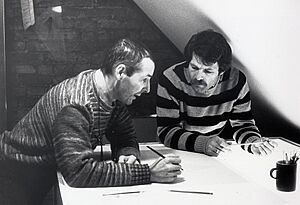Jack Chambers (artist) facts for kids
Quick facts for kids
Jack Chambers
|
|
|---|---|
 |
|
| Born |
John Richard Chambers
March 25, 1931 London, Ontario, Canada
|
| Died | April 13, 1978 (aged 47) London, Ontario, Canada
|
| Known for | Painter, filmmaker |
|
Notable work
|
The Hart of London, 1970 |
| Spouse(s) | Olga Sanchez Bustos (married 1963) |
Jack Chambers (born John Richard Chambers, March 25, 1931 – April 13, 1978) was a famous Canadian artist and filmmaker. He was born in London, Ontario.
Chambers' painting style changed over time. It went from being inspired by surrealism (dream-like art) to photo-realism (art that looks like a photograph). He called his unique style "Perceptual Realism" or "perceptualism."
In the 1960s, Jack Chambers also started making films. He finished six films by 1970. The famous filmmaker Stan Brakhage even called Chambers' movie The Hart of London "one of the greatest films ever made."
Contents
Jack Chambers' Life Story
John Richard Chambers was born in London, Ontario. He signed his artworks as John until 1970. After that, he was known as Jack.
He went to Sir Adam Beck Collegiate Institute in London. There, he learned from the painter Selwyn Dewdney in 1944. Later, he studied at H.B. Beal Secondary School and the University of Western Ontario.
Jack then spent eight years (1953–1961) studying and working in Europe. While there, he even met the famous artist Pablo Picasso. Chambers went to Picasso's house and climbed his gate to introduce himself! Picasso told him to keep studying in Barcelona.
When Jack Chambers returned to London, he worked with another artist from London, Greg Curnoe. In 1969, he was diagnosed with leukemia. For the rest of his life, he painted more realistically. He often showed places in London and the areas around it. An example is his painting 401 Towards London No. 1 (1968–1969). It shows a view of Highway 401 as you drive towards London.
In 1968, Jack Chambers started Canadian Artists' Representation (CARFAC). This is now a national group for artists. He created it after a disagreement with the National Gallery of Canada about artists' rights and payment for their work. In 1973, he won the Victor Martyn Lynch-Staunton Award.
You can find his artworks in important places. These include the National Gallery of Canada, the Art Gallery of Ontario, and Museum London. An elementary school in London, Jack Chambers Public School, is named after him. A tree was also planted in his memory in Gibbons Park after he passed away.
In 2012, the Art Gallery of Ontario held a special show of his work. This show helped many new people discover his amazing art.
Understanding Perceptual Realism
Jack Chambers developed his idea of "Perceptual Realism" in the late 1960s. He wrote an essay about it with the same name. He believed his way of seeing and painting was special.
Art expert Mark Cheetham describes it as "a deep and spiritual connection between art and what we first experience with our senses." This idea applies to Chambers' most famous films and paintings. Perceptual Realism tried to show the true nature of things using light and materials. Chambers called it "a way of inner vision where the object appears in its true, essential form."
Jack Chambers' Paintings
Jack Chambers learned the basics of his painting style while he was training in Spain. Many of his paintings from that time show the influence of Surrealism. Surrealism is an art style that uses dream-like images.
After he came back to Canada in 1961, he tried different ways to apply paint. He also used very bright colors. By the mid-1960s, his style changed again. He started to add a sense of movement and time into his paintings. In these works, shapes were broken up. He said, "A painting gets put together just like an experience – in particles."
In the mid-1960s, Chambers also made his "silver paintings." For these, he used a special aluminum paint. Other artists, like Andy Warhol, also experimented with this unusual metallic color.
Jack Chambers' Films
Between 1964 and 1970, Jack Chambers made six films. They ranged in length from nine minutes to 79 minutes. He worked with both black and white and color film.
His films were like montages. This means they put together many different short clips. On the surface, his films showed his home life and images of London, Ontario. But they also explored the difference between nature and society.
Jack Chambers died early and did not travel much with his films for festivals. Because of this, his films were not widely known in the early history of avant-garde film (experimental film). However, his movies, especially his longer film The Hart of London, have become very important in Canadian film history. They have also gained fame around the world.
Filmography
- Mosaic (1964–65, black and white, sound, 9 min.)
- Hybrid (1966, colour, silent, 15 min.)
- Little Red Riding Hood (with Greg Curnoe and James Reaney) (1967, colour, sound, 25 min.)
- R-34 (1967, colour, sound, 30 min.)
- Circle (1968–69, colour/black and white, sound, 28 min.)
- The Hart of London (1968–70, colour/black and white, sound, 79 min.)
- C.C.C.I. (unfinished) (c.1970)
- Life Still (unfinished) (c.1970)
Films About Jack Chambers
- Chambers (Fraser Boa, 1969, col., so., 41 min.)
- Jack Chambers (Cynthia Scott, CBC 'Man Alive' program, 1971, col., so., 52 min(?)
- Life Force (Peter Mellen, 1974, col., so., 26 min.)
- Chambers: Tracks and Gestures (Christopher Lowry and John Walker, 1982, col., so., 57 min.) (DVD Ecotone Productions)

